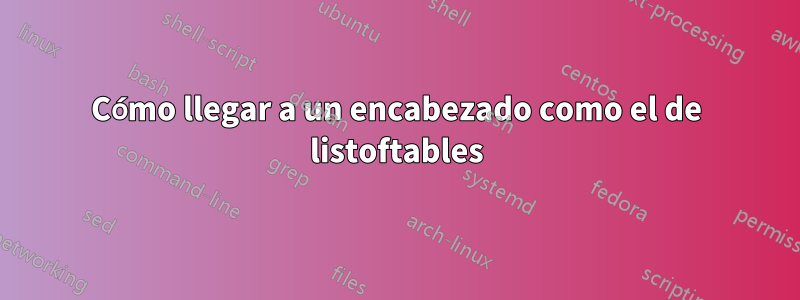
Quiero definir varios glosarios bajo un título que debería ser similar al de la tabla de contenido. Ya cambié el paquete de generación de glosarios de encabezados. ¿Cómo puedo configurar manualmente un encabezado en el estilo de la tabla de contenido? Resultado deseado: título como "Tabellenverzeichnis" sobre glosario con símbolos.
Mi (no tan) ejemplo de trabajo mínimo:
\documentclass{scrreprt}
\usepackage[utf8]{inputenc}
\title{example}
\author{hlorenz734 }
\date{August 2019}
\usepackage{natbib}
\usepackage{graphicx}
\usepackage{siunitx}
\usepackage[acronym,nomain,toc,automake]{glossaries-extra}
\setlength{\glsdescwidth}{0.9\textwidth}
\newglossary[slg]{symbolslistFU}{syi}{syg}{Verwendete Symbole für Furuta-Pendel} % create add. symbolslist
\renewcommand{\glossarysection}[2][]{} % no hjedaing sfor glossary
\glsaddkey{unit}{\glsentrytext{\glslabel}}{\glsentryunit}{\GLsentryunit}{\glsunit}{\Glsunit}{\GLSunit}
\makeglossaries % activate glossaries-package
\newglossarystyle{symbunitlong}{%
\setglossarystyle{long3col}% base this style on the list style
\renewenvironment{theglossary}{% Change the table type --> 3 columns
\begin{longtable}{lp{0.6\glsdescwidth}>{\centering\arraybackslash}p{2cm}}}%
{\end{longtable}}%
%
\renewcommand*{\glossaryheader}{% Change the table header
\bfseries Symbol & \bfseries Beschreibung & \bfseries Einheit \\
\hline
\endhead}
\renewcommand*{\glossentry}[2]{% Change the displayed items
\glstarget{##1}{\glossentryname{##1}} %
& \glossentrydesc{##1}% Description
& \glsunit{##1} \tabularnewline
}
}
\newglossaryentry{symbFU:thetai}{
name=$\theta_{\mathrm{i}}$,
description={Drehwinkel Arm i},
unit={\si{\radian}},
sort=thetai,
type=symbolslistFU
}
\newglossaryentry{symbFU:tau1}{
name=$\tau_{\mathrm{1}}$,
description={Drehmoment übertragen auf Arm 1},
unit={\si{\newton\meter}},
sort=tau1,
type=symbolslistFU
}
\begin{document}
\maketitle
\cleardoublepage
\tableofcontents %Table of contents
\cleardoublepage
\addcontentsline{toc}{chapter}{Tabellenverzeichnis} % Tabellenverzeichnis ins Inhaltsverzeichnis schreiben
\listoftables
%% Abkürzungs- und Symbolverzeichnis %%%%%%%%%%%%%%%%%%%%%%%%%%%%%%
\cleardoublepage
\addcontentsline{toc}{chapter}{Notation und verwendete Symbole}
\glssetnoexpandfield{unit} % https://tex.stackexchange.com/questions/269565/glossaries-how-to-customize-list-of-symbols-with-additional-column-for-units
\glsaddall
\printglossary[type=\acronymtype,style=long] % list of acronyms
\printglossary[type=symbolslistFU,style=symbunitlong] % list of symbols
\cleardoublepage
\section{Introduction}
There is a theory which states that if ever anyone discovers exactly what the Universe is for and why it is here, it will instantly disappear and be replaced by something even more bizarre and inexplicable.
There is another theory which states that this has already happened.
\section{Conclusion}
``I always thought something was fundamentally wrong with the universe'' \citep{adams1995hitchhiker}
\bibliographystyle{plain}
\bibliography{references}
\end{document}
Respuesta1
En reportclases similares scrreprtse utilizan elementos como la tabla de contenido, la lista de figuras o el glosario \chapter*para componer sus respectivos títulos. Si quieres imitar eso, simplemente usa explícitamente \chapter*.


